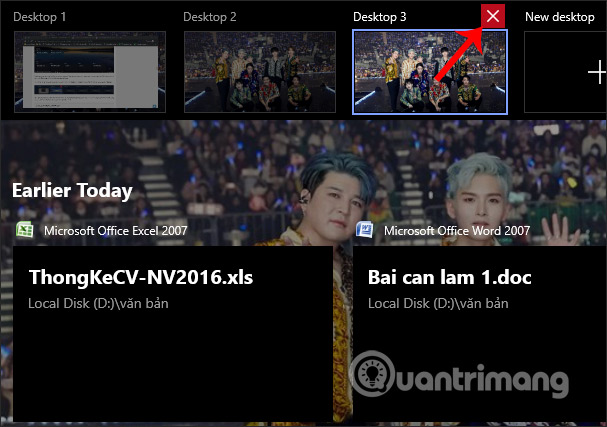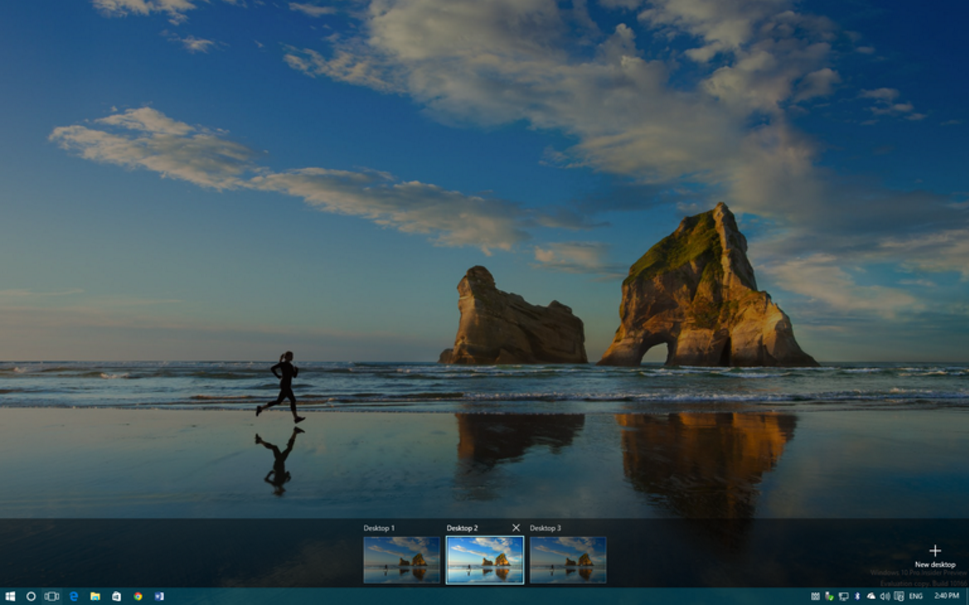How to use Virtual Desktop on Windows 10?
Features to use multiple virtual Windows Desktop computer screens have been provided on Windows 10 for a long time, enabling users to use multiple applications at the same time. We can create multiple computer screens according to user needs, with different programs used on each screen. And according to each version of Windows 10, the Multiple Desktop feature is more and more upgraded, more options among special screens are Windows 10 Timeline feature to save the history of opening files or accessing websites according to different times. The following article will guide you how to use the Virtual Desktop feature on previous versions of Windows 10 and from Windows 1706 or later.
- How to use 2 screens on a computer
- Two ways to pair the screen in Windows 7
- How to set the resolution for many Windows 10 screens
- 3 ways to set up different background images on each Windows 10 screen
Video tutorial for using Multiple Desktop Windows 10
1. How to use Virtual Desktop on Windows 10 (1706 and above)
Step 1:
In the Taskbar, click on the Task View icon as shown below or press the Windows + Tab key combination to open.

Step 2:
Display the current screen interface with open applications. To open a new screen, click on + NewDesktop .

Step 3:
Next, the new screen is created with sequential numbers. Users can open many different screens as needed, just click New desktop.

Step 4:
At the Task View interface, we can move any application to another screen, but you cannot switch back.

Or we can right-click the application you want to move and select Move to , select the screen you want to move in the current screen list or move to the new screen with New desktop.

Step 5:
In addition, when we right-click, we also have other options such as Snap right / Snap left that show the application window to the right / left of the screen interface, showing the application interface on all open screens.

Step 6:
In this Task View interface when clicking the magnifying glass icon , users enter the recently opened application or file name to search quickly, instead of having to turn off the currently open applications to search. Then the Timeline bar automatically switches the time bar to the most recent application opening time.

Step 7:
Finally, if you do not want to use the virtual screen anymore, you just need to click the X icon at the top of each screen to turn it off.

2. How to use Virtual Desktop on Windows 10
Step 1: Create a Desktop

To create a virtual Desktop, first open Task View by clicking on the Task View button in the Taskbar, or by pressing the Windows + Tab key combination .
On the Task View window, click New Desktop to add a virtual Desktop.
If you have 2 or more open Desktops, the Add a desktop button will display as a gray tile with a plus symbol (+).
In addition, you can easily add a new Desktop without having to access the Task View by pressing Windows + Ctrl + D.
Step 2: Switch between desktops

To switch between virtual desktops, open the Task View pane, then click the Desktop you want to open.
Also you can convert Desktops more easily and quickly without accessing Task View using Windows + Ctrl + left arrow and Windows + Ctrl + right arrows .
You can switch between virtual desktops unlimited number.
The Task View pane only displays 9 Desktops at the same time and no scrolling function.
Step 3: Move the window between Desktops

To move a window from one Desktop to another, first open the Task View pane, then move the mouse on the Desktop containing the window you want to move. At this time, a popup window will appear, find the window you want to move, right-click it, then select Move to and select the Desktop that you want to move that window to.
On Build 10166, Microsoft has integrated drag and drop functionality, you can keep and move the window you want to move, and then drop into the Desktop you want.
Step 4: Close a Desktop

To close a virtual Desktop, open the Task View pane, then hover over the Desktop that you want to close until the small X icon in the top right corner appears.
Click on the X icon to close the Desktop.
Alternatively, you can use Windows + Ctrl + F4 to close the Desktop without having to access the Task View pane.
Good luck!
You should read it
- How to set different wallpapers for virtual desktops on Windows 11
- Already able to test Windows 11 on Azure Virtual Desktop
- How to use virtual desktop on Windows 11
- Google officially introduces the virtual desktop feature on Chrome OS
- How to set different wallpapers on Windows 11
- Discover VDI in Server 2008 R2 Hyper-V
- How to move windows to another virtual desktop in Windows 10
- How to Use Multiple Virtual Desktops in Windows 10
May be interested
- Task View key, Virtual Desktop on Windows 10
 task view key, virtual desktop on windows 10. to access task view, create a virtual destop we have a lot of ways from manual to keyboard shortcuts. in this article, we will learn all the ways:
task view key, virtual desktop on windows 10. to access task view, create a virtual destop we have a lot of ways from manual to keyboard shortcuts. in this article, we will learn all the ways: - Chrome OS will support virtual desktops, which can operate similarly to Windows 10
 google is considering adding to chrome os a new feature that makes it not only look like but also works similar to windows 10.
google is considering adding to chrome os a new feature that makes it not only look like but also works similar to windows 10. - How to create and use virtual Desktop on Windows 10
 how to create and use virtual desktops on windows 10. virtual desktops (virtual desktops) is a new feature built into microsoft windows 10, many people do not pay attention to this new feature without knowing that this is a very feature. useful if you know c
how to create and use virtual desktops on windows 10. virtual desktops (virtual desktops) is a new feature built into microsoft windows 10, many people do not pay attention to this new feature without knowing that this is a very feature. useful if you know c - What is a virtual GPU?
 virtual gpu allows sharing on multiple virtual machines. this has greatly improved the performance of applications and desktops, as well as allowed organizations to build virtual desktop infrastructures, helping to increase cost efficiency for businesses.
virtual gpu allows sharing on multiple virtual machines. this has greatly improved the performance of applications and desktops, as well as allowed organizations to build virtual desktop infrastructures, helping to increase cost efficiency for businesses. - Quick experience Windows 365 Cloud PC on iPad
 microsoft's windows 365 cloud pc virtual desktop service is officially rolling out to eligible organizations and businesses. experience windows 365 cloud pc on ipad in 3 words: easy, stable, and fun.
microsoft's windows 365 cloud pc virtual desktop service is officially rolling out to eligible organizations and businesses. experience windows 365 cloud pc on ipad in 3 words: easy, stable, and fun. - Why is Virtual Desktop the most underrated feature on Chromebooks?
 while virtual desktop isn't a new feature for desktops, it could be a game-changer for chromebooks.
while virtual desktop isn't a new feature for desktops, it could be a game-changer for chromebooks. - New Cortana user interface, renamed Virtual Desktop, and some other interesting features will soon appear on Windows 10
 no need to spend much time analyzing new builds, experts have found some interesting features that microsoft is developing and applying on the new windows 10 18922 build.
no need to spend much time analyzing new builds, experts have found some interesting features that microsoft is developing and applying on the new windows 10 18922 build. - Turn the iPad into a true Windows 10 computer, support Bluetooth mouse
 the windows virtual desktop feature, a service based on microsoft's azure cloud platform, allows windows 10 to be used on any operating system, allowing turning the ipad into a truly windows 10-compatible computer with the mouse. and keyboard.
the windows virtual desktop feature, a service based on microsoft's azure cloud platform, allows windows 10 to be used on any operating system, allowing turning the ipad into a truly windows 10-compatible computer with the mouse. and keyboard. - Windows is now available for iPhone, iPad, Mac, and PC
 at the ignite 2023 event, microsoft announced windows app for iphone, ipad, mac and pc. the simply named app allows users to connect to windows 365, azure virtual desktop, microsoft dev box, and remote pcs from anywhere with an internet connection.
at the ignite 2023 event, microsoft announced windows app for iphone, ipad, mac and pc. the simply named app allows users to connect to windows 365, azure virtual desktop, microsoft dev box, and remote pcs from anywhere with an internet connection. - Leaks information about Microsoft's new Remote Desktop application
 microsoft is actively deploying the new remote desktop client, optimized for their windows virtual desktop ...
microsoft is actively deploying the new remote desktop client, optimized for their windows virtual desktop ...










 How to fix IRQL NOT LESS OR EQUAL errors on Windows
How to fix IRQL NOT LESS OR EQUAL errors on Windows How to fix '0x00000109: selected entry could not be loaded' on Windows
How to fix '0x00000109: selected entry could not be loaded' on Windows How to block Internet connection software, Windows 10 applications
How to block Internet connection software, Windows 10 applications How to convert Legacy BIOS to UEFI in Windows 10
How to convert Legacy BIOS to UEFI in Windows 10 Errors on the latest Windows 10 updates and how to fix them (updated continuously)
Errors on the latest Windows 10 updates and how to fix them (updated continuously) Microsoft warns, clicking Check for Updates will make the new Windows 10 update unstable
Microsoft warns, clicking Check for Updates will make the new Windows 10 update unstable